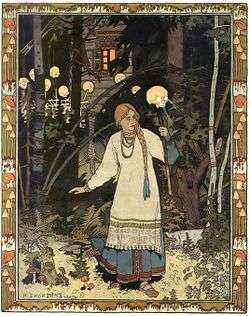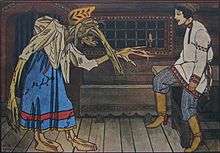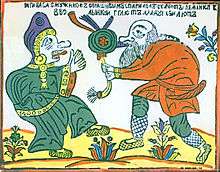Baba Yaga
In Slavic folklore, Baba Yaga (Bulgarian: Баба Яга, romanized: Baba Yaga; Russian: Ба́ба-Яга́) is a supernatural being (or a trio of sisters of the same name) who appears as a deformed or ferocious-looking old woman. In Russian folklore, Baba Yaga flies around in a mortar, wields a pestle, and dwells deep in the forest in a hut usually described as standing on chicken legs.[1]

Baba Yaga may help or hinder those that encounter her or seek her out. She may play a maternal role and has associations with forest wildlife. According to Vladimir Propp's folktale morphology, Baba Yaga commonly appears as either a donor, villain, or may be altogether ambiguous. Her depictions vary greatly across tales, ranging from a child-eating monster, to helping a protagonist find his missing bride.
Andreas Johns identifies Baba Yaga as "one of the most memorable and distinctive figures in eastern European folklore", and observes that she is "enigmatic" and often exhibits "striking ambiguity".[2] Johns summarizes Baba Yaga as "a many-faceted figure, capable of inspiring researchers to see her as a Cloud, Moon, Death, Winter, Snake, Bird, Pelican or Earth Goddess, totemic matriarchal ancestress, female initiator, phallic mother, or archetypal image".[3]
Etymology
Variations of the name Baba Yaga are found in the languages of the Eastern Slavic peoples. The first element, baba, is transparently a babble word. In Old Russian, baba may mean "midwife", "sorceress", or "fortune teller". In modern Russian, the word бабушка or babushka (meaning "grandmother") derives from it, as does the word babcia (also "grandmother") in Polish. In Serbo-Croatian, baba means "grandma". In contemporary, unofficial Polish baba is the pejorative synonym of "woman" (especially old, dirty or foolish woman). Baba may also have a pejorative connotation in modern Russian, both for women as well as for "an unmanly, timid, or characterless man".[3] Similarly to other kinship terms in Slavic languages, baba may be employed outside of kinship, potentially as a result of taboo. For example, in variety of Slavic languages and dialects, the word baba may be applied to various animals, natural phenomena, and objects, such as types of mushrooms or a cake or pear. This function extends to various geographic features. In the Polesia region of Ukraine, the plural baby may refer to an autumn funeral feast.[3]
These associations have led to variety of theories on the figure of Baba Yaga, though the presence of the element baba may have simply been taken as its primary meaning of "grandmother" or "old woman". The element may appear as a means of glossing the second element, iaga, with a familiar component. Additionally, baba may have also been applied as a means of distinguishing Baba Yaga from a male counterpart.[3]
While a variety of etymologies have been proposed for the second element of the name, Yaga, it remains far more etymologically problematic and no clear consensus among scholars has resulted. For example, in the 19th century, Alexander Afanasyev proposed the derivation of Proto-Slavic *ož and Sanskrit ahi ('serpent, snake'). This etymology has subsequently been explored by other scholars in the 20th century.[4]
Related terms to the second element of the name, Yaga, appear in various Slavic languages; Serbo-Croatian jeza ("horror", "shudder", "chill"), Slovene jeza ("anger"), Old Czech jězě ("witch", "legendary evil female being"), modern Czech jezinka ("wicked wood nymph", "dryad"), and Polish jędza ("witch", "evil woman", "fury"). The term appears in Old Church Slavonic as jęza/jędza (meaning "disease", "illness"). In other Indo-European languages the element iaga has been linked to Lithuanian engti ("to abuse (continuously)", "to belittle", "to exploit"), Old English inca ("doubt", "worry", "pain"), and Old Norse ekki ("pain", "worry").[4]
Attestations

Folktales
Baba Yaga has appeared in hundreds if not thousands of folktales in Russia, Ukraine, and Belarus predating the eighteenth century. The first clear reference to Baba Yaga (Iaga baba) occurs in 1755; Mikhail V. Lomonosov's Rossiiskaia grammatika ('Russian grammar'). In Lomonosov's grammar, Baba Yaga is mentioned twice among other figures largely from Slavic tradition. The second of the two mentions occurs within a list of Slavic gods and beings next to their presumed equivalence in Roman mythology (the Slavic god Perun, for example, appears equated with the Roman god Jupiter). Baba Yaga, however, appears in a third section without an equivalence, attesting to perception of her uniqueness even in this first known attestation.[5]
In the narratives in which Baba Yaga appears, she displays a variety of typical attributes: a turning, chicken-legged hut; and a mortar, pestle, mop or broom. Baba Yaga frequently bears the epithet "bony leg" (Baba Iaga kostianaia noga), and when inside of her dwelling, she may be found stretched out over the stove, reaching from one corner of the hut to another. Baba Yaga may sense and mention the "Russian scent" (russkim dukhom) of those that visit her. Her nose may stick into the ceiling. Particular emphasis may be placed by some narrators on the repulsiveness of her nose, breasts, buttocks, or vagina.[6]
In many tales, there are three Baba Yagas which are often depicted as sisters.[7] For example, in a version of "The Maiden Tsar" collected in the 19th century by Alexander Afanasyev, Ivan, a handsome merchant's son, makes his way to the home of one of three Baba Yagas:
He journeyed onwards, straight ahead .. and finally came to a little hut; it stood in the open field, turning on chicken legs. He entered and found Baba Yaga the Bony-legged. "Fie, fie," she said, "the Russian smell was never heard of nor caught sight of here, but it has come by itself. Are you here of your own free will or by compulsion, my good youth?" "Largely of my own free will, and twice as much by compulsion! Do you know, Baba Yaga, where lies the thrice tenth kingdom?" "No, I do not," she said, and told him to go to her second sister; she might know.[8]

Ivan walks for some time before encountering a small hut identical to the first. This Baba Yaga makes the same comments and asks the same question as the first, and Ivan asks the same question. This second Baba Yaga does not know either and directs him to the third, but says that if she gets angry with him "and wants to devour you, take three horns from her and ask her permission to blow them; blow the first one softly, the second one louder, and third still louder". Ivan thanks her and continues on his journey.[9]
After walking for some time, Ivan eventually finds the chicken-legged hut of the youngest of the three sisters turning in an open field. This third and youngest of the Baba Yagas makes the same comment about "the Russian smell" before running to whet her teeth and consume Ivan. Ivan begs her to give him three horns and she does so. The first he blows softly, the second louder, and the third louder yet. This causes birds of all sorts to arrive and swarm the hut. One of the birds is the firebird, which tells him to hop on its back or Baba Yaga will eat him. He does so and the Baba Yaga rushes him and grabs the firebird by its tail. The firebird leaves with Ivan, leaving Baba Yaga behind with a fist full of firebird feathers.[9]
In Afanasyev's collection of tales, Baba Yaga also appears in "The Magic Swan Geese", "Baba Yaga and Zamoryshek", "By Command of the Prince Daniel", "Vasilisa the Fair", "Marya Moryevna", "Realms of Copper, Silver, and Gold", "The Sea Tsar and Vasilisa the Wise", and "Legless Knight and Blind Knight" (English titles from Magnus's translation).[10] In some of these tales, a Baba Yaga will die only to rise again in another form.[7]
Lubki

Baba Yaga appears on a variety of lubki (singular lubok), wood block prints popular in late 17th and early 18th century Russia. In some instances, Baba Yaga appears astride a pig going to battle against a reptilian entity described as a "crocodile". Some scholars interpret this scene as a political parody. Peter the Great persecuted Old Believers, who in turn referred to him as a "crocodile". Some instances of the lubki feature a ship below the crocodile, and Baba Yaga appears in what some scholars identify as Finnish dress, and Catherine I, Peter the Great's wife, was sometimes derisively referred to by way of a word referring to Finnish women (Russian chukhonka).[11]
Another lubok features Baba Yaga dancing with a bagpipe-playing bald man. In turn, some scholars have identified this as a merrier depiction of the home life of Peter the Great and Catherine I. Alternately, some scholars have interpreted these lubki motifs as reflecting a concept of Baba Yaga as a shaman, according to which the "crocodile" would represent a monster who fights witches. The print would therefore be something of a "cultural mélange" that "demonstrate[s] an interest in shamanism at the time". Contemporary to the production of the lubki, the Finnic peoples still practiced a form of shamanism.[12]
According to scholar Andreas Johns, "Neither of these two interpretations significantly changes the image of Baba Yaga familiar from folktales. Either she can be seen as a literal evil witch, treated somewhat humorously in these prints, or as a figurative 'witch', an unpopular foreign empress. Both literal and figurative understandings of Baba Yaga are documented in the nineteenth century and were probably present at the time these prints were made."[12]
Related figures and analogues
Ježibaba, a figure closely related to Baba Yaga, occurs in the folklore of the West Slavic peoples. The name Ježibaba and its variants are directly related to that of Baba Yaga. The two figures may stem from a common figure as far back as the medieval period, if not further, and both figures are at times similarly ambiguous. The two differ in their occurrence in different tale types and in details regarding their appearances. Questions linger regarding the limited Slavic area—East Slavic nations, Slovakia, and the Czech lands—in which references to Ježibaba are recorded.[13] Another related figure appears in Polish folklore by the name of Jedza.[14]
Scholars have identified a variety of beings in folklore who share similarities of varying extent with Baba Yaga. These similarities may be due to either direct relation or cultural contact between the Eastern Slavs and other surrounding peoples. In Eastern Europe, these figures include the Bulgarian gorska maika (Горска майка', 'Forest Mother', also the name of a flower); the Serbian Baba Korizma, Gvozdenzuba ('Iron-tooth'), Baba Roga (used to scare children in Bosnia, Croatia, Montenegro and Serbia), šumska majka ('Forest Mother'), and the babice; and the Slovenian jaga baba or ježibaba, Pehta or Pehtra baba and kvatrna baba or kvatrnica. In Romanian folklore, similarities have been identified in several figures, including Mama padurii ('Forest Mother'). In neighboring Germanic Europe, similarities have been observed between the Alpine Perchta and Holda or Holle in the folklore of Central and Northern Germany, and the Swiss Chlungeri.[15]
Some scholars have proposed that the concept of Baba Yaga was influenced by East Slavic contact with Finno-Ugric and Siberian peoples.[16] The Karelian Syöjätär has some aspects of Baba Yaga, but only the negative ones, while in other Karelian tales, helpful roles akin to those from Baba Yaga may be performed by a character called akka (Karelian for "old woman").[17]
Modern influence
- In 1899, the illustrator Ivan Bilibin depicted Baba Yaga in his illustrations for "Vasilisa the Beautiful", a Russian folktale collected in Alexander Afanasyev's Narodnye russkie skazki.
- Baba Yaga's Assistant written by Marika McCoola; illustrated by Emily Carroll.[18]
- In the novel Ask Baba Yaga: Otherworldly Advice for Everyday Troubles by Taisia Kitaiskaia, the character of Baba Yaga gives advice for contemporary life.[19]
- Baba Yaga appears as a character in the book The Door By the Staircase by Katherine Marsh; illustrated by Kelly Murphy.[20]
- In The House With Chicken Legs by Sophie Anderson, the protagonist's grandmother is a Yaga.[21]
- Under the name "Babs Yagg" she appears in '.Vassa in the Night by Sarah Porter.[22]
- Baba Yaga appears in the television series Monsters of the Week.[23]
- She appears as a minor character in The Winter of the Witch by Katherine Arden, the third book in the Winternight trilogy that features many characters from Russian folklore.[24]
- Baba Yaga is a recurring character in the comic book series Hellboy.
- Baba Yaga appears as a minor character in several of Patricia Briggs books of Mercy Thompson. In her most recent book, Storm Cursed, Baba Yaga assists Mercy and her husband Adam Hauptman, while mentioning that Adam smells like a handsome Russian man.
- In Orson Scott Card's Enchantment (1999), Baba Yaga is the antagonist in a time-traveling Sleeping Beauty-esque story.[25]
- Baba Yaga appears a supporting character in the 1999 animated film Bartok the Magnificent.
- In the 2014 film John Wick, the title character is referred to in subtitles as a boogeyman, but the spoken words are "Baba Yaga".
- In the 2015 video game Rise of the Tomb Raider, there is a DLC (downloadable content) dedicated to Baba Yaga, titled Baba Yaga: The Temple of the Witch. The game's setting is in the depths of the Siberia wilderness.
- In the 2018 film Ant-Man and the Wasp, Ghost, one of the antagonists of the story has the ability to phase through walls. This frightens a Slavic character in the movie to assume that she is Baba Yaga.
- Baba Yaga is a character in the novel Egg and Spoon by Gregory Maguire
- As of 2020, Baba Yaga is featured as a playable character in the MOBA Smite.[26] created by Hi-Rez Studios.
See also
- Koschei the Deathless, common male antagonist in Russian folktales
- Vasilisa the Beautiful, common female protagonist in Russian folktales
- Yama-uba, a similar character to Baba Yaga, in Japanese folklore.
Notes
- Sibelan, Skoro & Zipes (2013), p. viii.
- Johns (2004), pp. 1–3.
- Johns (2004), p. 9.
- Johns (2004), p. 10.
- Johns (2004), p. 12.
- Johns (1998), p. 21.
- Sibelan, Forrester; Zipes, Jack; Skoro, Martin (2013). The Wild Witch of the East in Russian Fairy Tales. University Press of Mississippi. p. 257. ISBN 9781621039433.}
- Guterman (1973), p. 231.
- Guterman (1973), p. 232.
- Afanasyev (1916)
- Johns (2004:15).
- Johns (2004:15–16).
- Johns (2004), p. 61–66.
- Hubbs (1993), p. 40
- Johns (2004), pp. 68–84.
- Johns (2004), p. 61.
- Johns (2004), pp. 80–82.
- 2015. Baba Yaga's Assistant by Marika McCoola. Candlewick. ISBN 9780763669614.
- 2017. Ask Baba Yaga: Otherworldly Advice for Everyday Troubles by Taisia Kitaiskaia. Andrews McMeel Publishing. ISBN 978-1449486815.
- 2017. The Door By the Staircase by Katherine Marsh. Disney-Hyperion. ISBN 978-1423137856.
- 2018. The House With Chicken Legs by Sophie Anderson. Scholastic Press. ISBN 978-1338209969.
- 2016. Vassa in the Night by Sarah Porter. Tor Teen. ISBN 978-0765380548.
- Rudy, Jill Terry; McDonald, Jarom Lyle (2016). "Monsters of the Week, and Pop Culture's Formation of Wonder and Families through Monstrosity". Humanities. 5 (2): 40, 17. doi:10.3390/h5020040.
- 2019. The Winter of the Witch by Katherine Arden. Del Rey. ISBN 978-1101886014.
- Buker, Derek M. (2002). Science Fiction and Fantasy Readers' Advisory: The Librarian's Guide to Cyborgs, Aliens, and Sorcerers. American Library Association. p. 130. ISBN 978-0-8389-0831-0.
- "Baba Yaga Witch of the Woods". Smite.
References
- Afanasyev, Alexander (1916), Magnus, Leonard A. (ed.), Russian Folk-Tales, Kegan Paul, Trench, Trubner & Co.
- Afanasev, Aleksandr (1973) [1945]. Guterman, Norbert (ed.). Russian Fairy Tales. Pantheon Books.
- Hubbs, Joanna (1993). Mother Russia: The Feminine Myth in Russian culture (1st Midland Book ed.). Bloomington: Indiana University Press. ISBN 978-0253208422. OCLC 29539185.
- Johns, Andreas (1998). "Baba Yaga and the Russian Mother". The Slavic and East European Journal. American Association of Teachers of Slavic and East European Languages. 42 (1): 21–36. doi:10.2307/310050. JSTOR 310050.
- Johns, Andreas (2004). Baba Yaga: The Ambiguous Mother and Witch of the Russian Folktale. Peter Lang. ISBN 978-0-8204-6769-6.
- Murphey, Kathleen (2018). "BABA YAGA, THE INTERSEX WITCH". Pennsylvania Literary Journal (2151-3066). 10 (2): 210–214.
- Rudy, Jill Terry; McDonald, Jarom Lyle (2016). "Baba Yaga, Monsters of the Week, and Pop Culture's Formation of Wonder and Families through Monstrosity". Humanities (2076-0787). 5 (2): 40, 17p. doi:10.3390/h5020040.
- Armknecht, Megan; Rudy, Jill Terry; Forrester, Sibelan (2017). "Identifying Impressions of Baba Yaga: Navigating the Uses of Attachment and Wonder on Soviet and American Television". Marvels & Tales. 31 (1): 62–79, 18. doi:10.13110/marvelstales.31.1.0062. S2CID 55374676.
- Sibelan, Forrester; Zipes, Jack; Skoro, Martin (2013). Baba Yaga : The Wild Witch of the East in Russian Fairy Tales. University Press of Mississippi. p. 257. ISBN 9781621039433.
External links
